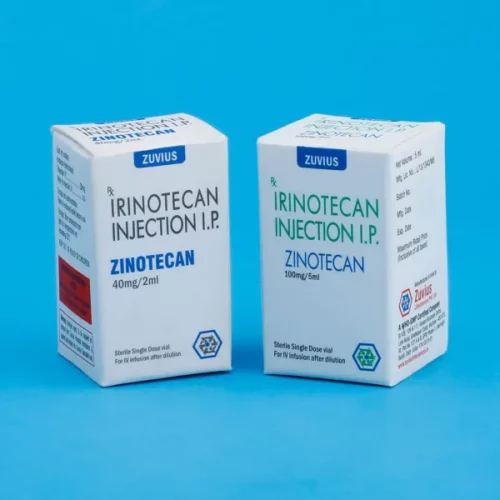Anastroz Tab (Test)
Anastrozole Tab
Strength: 1mg
Pack Size: 1 x 10
Drug Class: Enzyme inhibitors
Dosage and Administration:
The dose of Anastrozole is one 1 mg tablet taken once a day. For patients with advanced breast cancer. Anastrozole should be continued until tumor progression.
For adjuvant treatment of early breast cancer in postmenopausal women, the optimal duration of therapy is unknown. In the ATAC trial Anastrozole was administered for five years.
PATIENTS WITH HEPATIC IMPAIRMENT
Hepatic metabolism accounts for approximately 85% of Anastrozole elimination. Although clearance of Anastrozole was decreased in patient with cirrhosis due to alcohol abuse, plasma Anastrozole concentrations stayed in the usual range seen in patients without liver disease. Therefore, no changes in dose are recommrnded for patients with mild – to – moderate hepatic impairment, although patients should be monitored for side effects. Anastrozole has not been studied in patients with severe hepatic impairment.
PATIENTS WITH RENAL IMPAIRMENT
No changes in dose are necessary for patients with renal impairment.
USE IN THE ELDERLY
No dosage adjustment is necessary.
Cold Storage: no
Anastrozole tablets for oral administration contain 1 mg of anastrozole, a non-steroidal aromatase inhibitor. It is chemically described as 1,3-Benzenediacetonitrile, a, a, a’, a’-tetramethyl-5-(1H-1,2,4-triazol-1-ylmethyl). Its molecular formula is C17H19N5 and its structural formula is:
 |
Anastrozole is an off-white powder with a molecular weight of 293.4. Anastrozole has moderate aqueous solubility (0.5 mg/mL at 25°C); solubility is independent of pH in the physiological range. Anastrozole is freely soluble in methanol, acetone, ethanol, and tetrahydrofuran, and very soluble in acetonitrile.
Each tablet contains as inactive ingredients: lactose, magnesium stearate, hydroxypropylmethylcellulose, polyethylene glycol, povidone, sodium starch glycolate, and titanium dioxide.
Indication-:
Anastrozole is indicated for adjuvant treatment of postmenopausal women with hormone receptor positive early breast cancer.
Anastrozole is indicated for the first – line treatment of postmenopausal women with hormone receptor positive or hormone receptor unknown locally advanced or metastatic breast cancer.
Anastrozole is indicated for the treatment of advanced breast cancer in postmenopausal women with dieases progression following tamoxifen therapy. Patients with ER-negative disease and paitents who did not respond to previous tamoxifen therapy rarely responded to Anastrozole.
Usage-:
Anastrozole is used to treat early hormone receptor-positive breast cancer. It is also used for first-line treatment of hormone receptor-positive or hormone receptor-unknown advanced or metastatic (cancer that has spread) breast cancer
Clinical efficacy and safety
Advanced breast cancer
First-line therapy in postmenopausal women with advanced breast cancer
Two double-blind, controlled clinical studies of similar design (Study 1033IL/0030 and Study 1033IL/0027) were conducted to assess the efficacy of Anastroz compared with tamoxifen as first-line therapy for hormone receptor-positive or hormone receptor-unknown locally advanced or metastatic breast cancer in postmenopausal women. A total of 1,021 patients were randomised to receive 1 mg of Anastroz once daily or 20 mg of tamoxifen once daily. The primary endpoints for both trials were time to tumour progression, objective tumour response rate, and safety
Second-line therapy in postmenopausal women with advanced breast cancer
Anastroz was studied in two controlled clinical trials (Study 0004 and Study 0005) in postmenopausal women with advanced breast cancer who had disease progression following tamoxifen therapy for either advanced or early breast cancer. A total of 764 patients were randomised to receive either a single daily dose of 1 mg or 10 mg of Anastroz or megestrol acetate 40 mg four times a day. Time to progression and objective response rates were the primary efficacy variables. The rate of prolonged (more than 24 weeks) stable disease, the rate of progression, and survival were also calculated. In both studies there were no significant differences between treatment arms with respect to any of the efficacy parameters.
Adjuvant treatment of early invasive breast cancer for hormone receptor-positive patients
In a large phase III study conducted in 9,366 postmenopausal women with operable breast cancer treated for 5 years (see below), Anastroz was shown to be statistically superior to tamoxifen in disease-free survival. A greater magnitude of benefit was observed for disease-free survival in favour of Anastroz versus tamoxifen for the prospectively defined hormone receptor-positive population
Adjuvant treatment of early invasive breast cancer for hormone receptor-positive patients being treated with adjuvant tamoxifen
In a phase III trial (Austrian Breast and Colorectal Cancer Study Group [ABCSG] 8) conducted in 2,579 postmenopausal women with hormone receptor-positive early breast cancer who had received surgery with or without radiotherapy and no chemotherapy (see below), switching to Anastroz after 2 years adjuvant treatment with tamoxifen was statistically superior in disease-free survival when compared to remaining on tamoxifen, after a median follow-up of 24 months.
Bone mineral density (BMD)
In the phase III/IV study (Study of Anastrozole with the Bisphosphonate Risedronate
[SABRE]), 234 postmenopausal women with hormone receptor-positive early breast cancer scheduled for treatment with Anastroz 1 mg/day were stratified to low, moderate and high risk groups according to their existing risk of fragility fracture. The primary efficacy parameter was the analysis of lumbar spine bone mass density using DEXA scanning. All patients received treatment with vitamin D and calcium. Patients in the low risk group received Anastroz alone (N=42), those in the moderate group were randomised to Anastroz plus risedronate 35 mg once a week (N=77) or Anastroz plus placebo (N=77) and those in the high risk group received Anastroz plus risedronate 35 mg once a week (N=38). The primary endpoint was change from baseline in lumbar spine bone mass density at 12 months.
Anastrozole may cause or worsen osteoporosis. It can decrease the density of your bones and increase the chance of broken bones and fractures. Talk to your doctor about the risks of taking this medication and to find out what you can do to decrease these risks.
Anastrozole may cause other side effects.
General
Anastrozole is not recommended for use in premenopausal women as safety and efficacy has not been established Before starting treatment with Anastrozole, pregnancy must be excluded. Anastrozole should be administered under the supervision of a qualified physician experienced in the use of anticancer agents.
PREGNANCY – PREGNANCY CATEGORY D – NURSING MOTHERS
It is not known if Anastrozole is excreted in human milk. Because many drugs are excreted in human milk, caution should be exercised when Anastrozole is administered to a nursing woman.
PEDIATRIC USE
The safety and efficacy of Anastrozole in pediatric patients have not been established.









